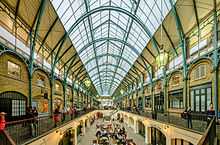Will's Coffee House
For several decades after the Restoration, Will's Coffee House in Russell Street, Covent Garden, at the northwest corner of Bow Street, was the London centre of the Wits,[1] centring on the figure of John Dryden, who liked to frequent the coffee house that had been founded by Will Unwin.[2] With the departure of John Dennis, William Wycherley complained in a well-known letter, "nor is Wills the Wits Coffee-House any more, since you left it, whose Society for want of yours is grown as Melancholly, that is as dull as when you left 'em a Nights, to their own Mother-Wit, their Puns, Couplets, or Quibbles...."[3] "This place is much altered since Mr Dryden frequented it," recalled Richard Steele in The Tatler afterwards; "where you used to see songs, epigrams, and satires in the hands of every man you met, you have now only a pack of cards."[4]
Will's is mentioned repeatedly in the diary of Samuel Pepys, who first dropped in on the evening of 3 February 1663/4:
"where Dryden the poet, I knew at Cambridge, and all the wits of the town, and Harris the player and Mr. Hoole of our College. And, had I time then, or could at other times, it will be good coming thither, for there, I perceive, is very witty and pleasant discourse".
Jonathan Swift. for his part, did not recall it so positively: "And indeed the worst conversation I ever remember to have heard in my life was that at Will's coffee-house, where the wits (as they were called) used formerly to assemble."[5]
From their first appearance in London [6] coffeehouses were centers of sociability, each one frequented by certain professions, a centre of communication for news and information. At Will's gathered those gentlemen of no profession at all and circulated their scurrilous epigrams and satires, and criticized the latest productions on stage or in print.
After Dryden's death (May 1700), the reputation of Will's declined rapidly, though it is noted in Daniel Defoe's Journey Through England. Though in the first number of The Tatler Poetry was promised under the heading Will's Coffee-house,[7] it was severely reviewed by Richard Steele in The Tatler, 8 April 1709, and fashion soon passed to Button's across the way, where Joseph Addison established Daniel Button in business, about 1712.[8]
References
- ↑ A Ellis, The Penny Universities: A history of the coffee-houses, 1956; Steve Pincus, "'Coffee Politicians Does Create': Coffeehouses and Restoration Political Culture" The Journal of Modern History, 67 (December 1995:807-34); Brian Cowan, The Social Life of Coffee: the emergence of the British coffeehouse, 2005;
- ↑ 'Bow Street and Russell Street Area: Bow Street', Survey of London: volume 36: Covent Garden (1970), pp. 185-192. Date accessed: 8 July 2009; this gives the history of the site.
- ↑ Wycherley to Dennis, Letter lxxix in A select Collection of Original Letters, written by the Most Eminent Persons... (London, 1760) vol. ii:118f.
- ↑ Steele, The Tatler, no. 1, 12 April 1709 from "Will's Coffee-house",
- ↑ Quoted in Raymond F. Howes, "Jonathan Swift and the conversation of the coffee-house", Quarterly Journal of Speech, 17.1 (February 1931:14-24).
- ↑ Pasqua Rosée, a native of Ragusa, opened a coffee-house in St. Michael's Alley, Cornhill, in 1652
- ↑ "All accounts of Gallantry, Pleasure, and Entertainment shall be under the Article of White's Chocolate-house; Poetry, under that of Will's Coffee-house; Learning, under the title of Graecian; Foreign and Domestick News, you will have from St. James' Coffee-house."
- ↑ William Harrison Ukers, All about Coffee, 1922:574-76.
Coordinates: 51°30′46″N 0°07′17″W / 51.51280°N 0.12133°W
